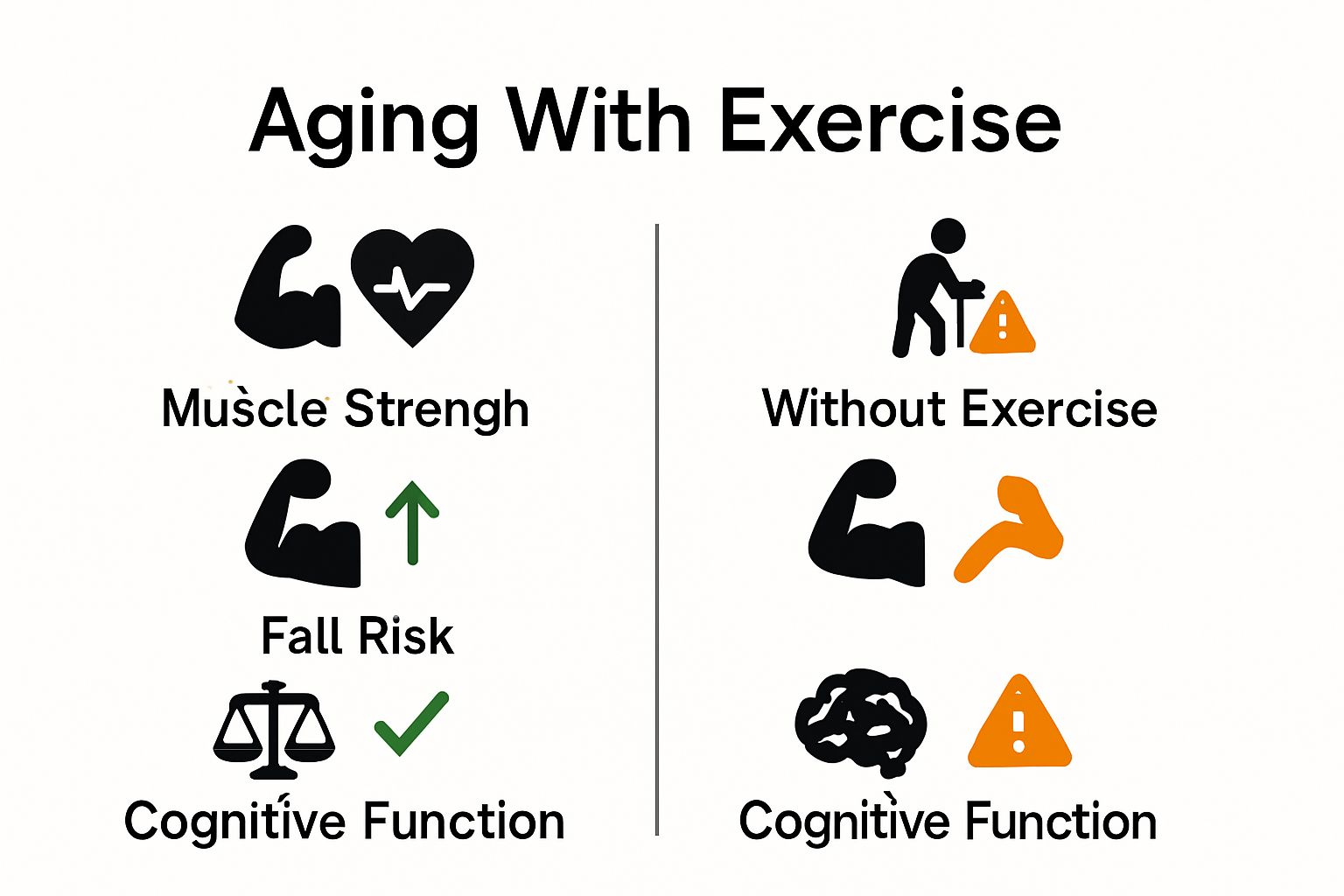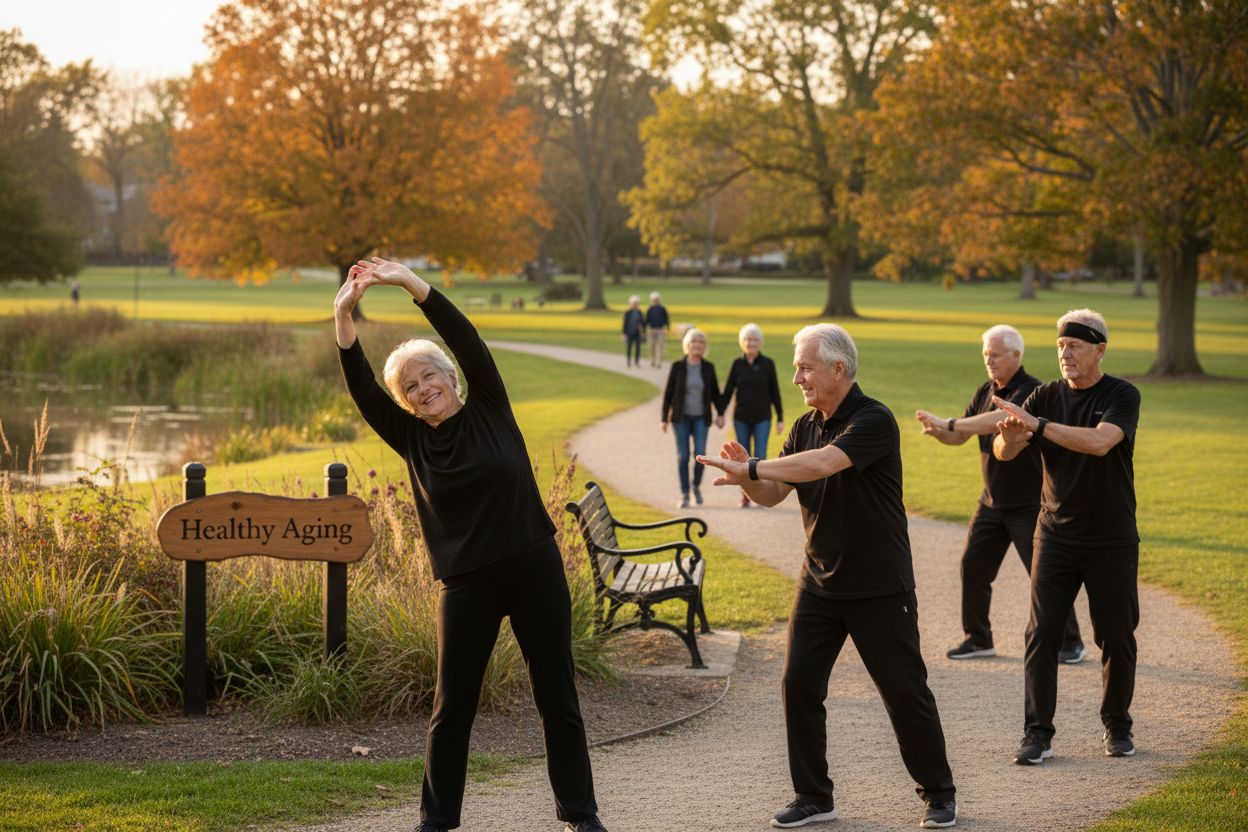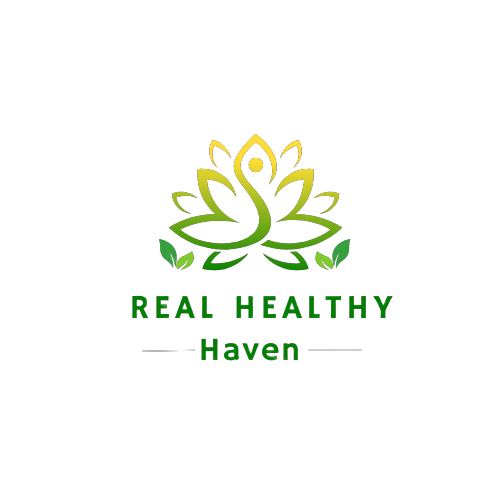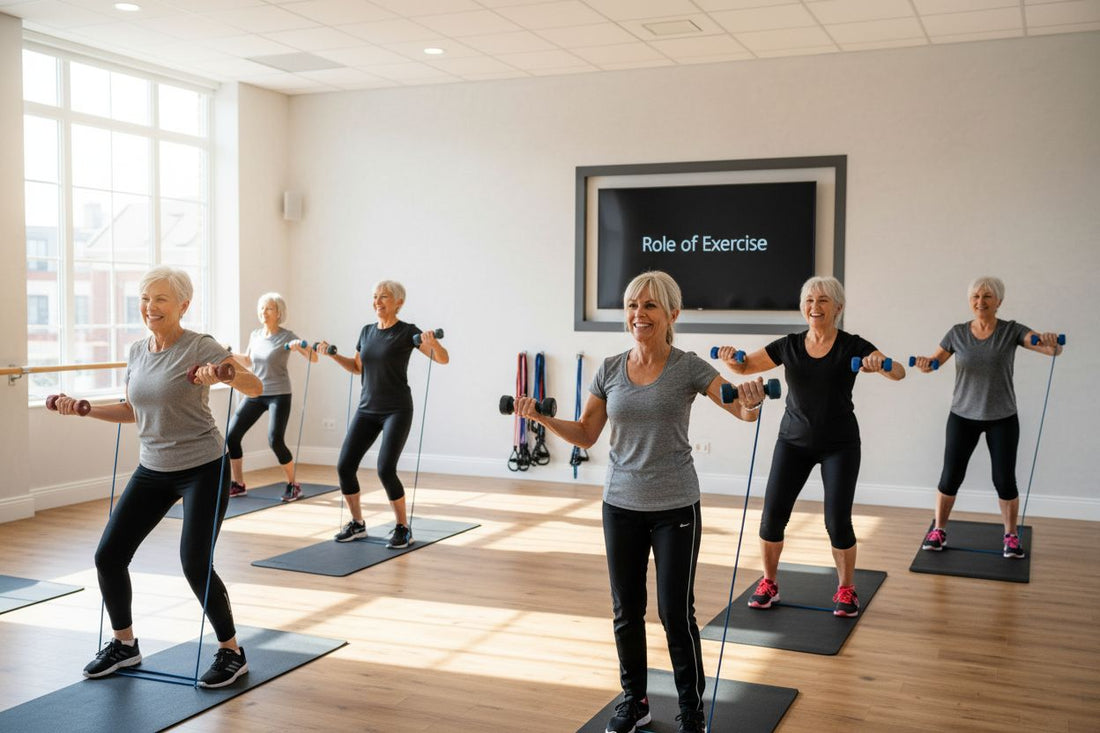Exercise is far more than just a way to stay in shape as you get older. Many people expect aging to bring steady physical decline, but studies show that regular activity can actually reverse some age-related changes. In fact, older adults who exercise regularly can reduce their risk of chronic disease by up to 35 percent. That is not what most people picture when they think about aging.
Table of Contents
- What Is The Role Of Exercise In Aging?
- Why Exercise Is Important For Healthy Aging
- How Exercise Influences Physical And Mental Health
- Understanding The Biological Changes In Aging And Exercise
- Practical Applications Of Exercise For Older Adults
Quick Summary
| Takeaway | Explanation |
|---|---|
| Exercise significantly improves aging outcomes. | Regular physical activity can enhance health, vitality, and overall quality of life in mature adults. |
| Customized exercise plans are essential. | Tailor workouts to individual health, capabilities, and preferences to ensure safety and effectiveness. |
| Exercise aids cognitive health and mental well-being. | Physical activity enhances brain function, reduces anxiety, and fosters a sense of community and connection. |
| Movement counters physiological decline. | Engaging in regular exercise helps combat age-related loss of muscle, bone density, and mental acuity. |
| Holistic benefits from diverse exercise types. | Incorporating strength, balance, cardio, and flexibility can address multiple health dimensions for older adults. |
What is the Role of Exercise in Aging?
Exercise represents a powerful intervention in the aging process, serving as more than just a physical activity but a comprehensive strategy for maintaining health and vitality. Understanding the role of exercise in aging reveals its transformative potential in slowing physiological decline and enhancing overall quality of life.
Biological Mechanisms of Exercise
As we age, our body experiences natural metabolic changes that can compromise physical function and cellular health. Exercise acts as a potent counterforce to these degenerative processes. Scientific research from the National Institute on Aging demonstrates that regular physical activity triggers critical biological responses that combat aging at the cellular level.
Key biological mechanisms include:
- Mitochondrial Enhancement: Exercise stimulates mitochondrial efficiency, improving cellular energy production
- Inflammation Reduction: Regular physical activity decreases chronic inflammatory markers
- Telomere Preservation: Physical activity helps maintain telomere length, potentially slowing cellular aging
These intricate processes highlight how exercise functions as a sophisticated intervention against age related deterioration.
Functional Benefits for Mature Adults
Beyond cellular mechanisms, exercise delivers profound functional advantages for aging individuals. Research published in the Journal of Aging and Physical Activity reveals multiple critical benefits:
- Improved muscle strength and joint flexibility
- Enhanced balance and reduced fall risk
- Maintenance of cognitive function and mental acuity
- Better metabolic health and weight management
Regular physical activity transforms aging from a process of decline into an opportunity for continued physical and mental engagement. The body responds dynamically to consistent movement, rebuilding and maintaining functional capacity far beyond traditional expectations.
While individual exercise needs vary, the fundamental principle remains consistent: movement is medicine. Engaging in age appropriate physical activities can dramatically influence how we experience and navigate the aging process, turning potential limitations into opportunities for continued growth and wellness.
Why Exercise is Important for Healthy Aging
Exercise is not merely a lifestyle recommendation but a fundamental strategy for maintaining physical and mental wellness as individuals progress through later life stages. Beyond simple physical activity, exercise represents a comprehensive approach to counteracting the natural progression of aging and preserving overall quality of life.
Preventing Age Related Decline
Aging inevitably brings physiological changes that can compromise mobility, strength, and independence. Health Canada research emphasizes that targeted physical activity can significantly mitigate these potential challenges. Regular exercise acts as a protective mechanism against multiple age related conditions by:
- Maintaining muscle mass and preventing sarcopenia
- Supporting cardiovascular health
- Improving bone density and reducing fracture risks
- Enhancing neurological plasticity
These preventative benefits transform exercise from an optional activity to a critical health intervention for mature adults.

Mental Health and Cognitive Preservation
Physical activity offers profound mental health advantages that extend far beyond muscular fitness. Neurological studies demonstrate that consistent exercise stimulates brain plasticity, potentially reducing cognitive decline risks. Regular physical engagement supports psychological well being by:
- Reducing stress and anxiety symptoms
- Promoting better sleep patterns
- Increasing neurochemical production associated with mood regulation
- Creating opportunities for social interaction
Cognitive preservation becomes increasingly crucial as individuals age, making exercise a powerful tool for maintaining mental sharpness and emotional resilience.
Ultimately, exercise represents an investment in long term health and independence. By embracing consistent physical activity, mature adults can dramatically influence their aging trajectory, transforming potential limitations into opportunities for continued growth, vitality, and engagement with life.

How Exercise Influences Physical and Mental Health
Exercise emerges as a transformative intervention that profoundly impacts both physical and mental wellness, offering a holistic approach to health optimization. The interconnected relationship between physical movement and overall well being reveals complex physiological and neurological mechanisms that extend far beyond traditional fitness concepts.
Physical Health Transformation
Physical activity triggers comprehensive bodily responses that enhance multiple health systems simultaneously. Regular exercise generates adaptive changes that strengthen the body’s fundamental functioning. Research from the National Institutes of Health demonstrates significant physiological benefits including:
- Enhanced cardiovascular efficiency
- Improved metabolic regulation
- Strengthened immune system responses
- Optimized hormonal balance
- Reduced chronic disease risk
These physiological adaptations represent the body’s remarkable capacity to respond and improve through consistent physical engagement.
Neurological and Psychological Impacts
Beyond physical improvements, exercise produces remarkable neurological transformations. Physical activity stimulates neurogenesis, the production of new brain cells, and enhances cognitive plasticity. The brain responds to movement by:
- Increasing neurotransmitter production
- Improving neural connectivity
- Reducing stress hormone levels
- Promoting emotional regulation
- Supporting memory and cognitive processing
The intricate connection between physical movement and mental functioning illustrates how exercise serves as a powerful neurological intervention, potentially mitigating age related cognitive decline.
By integrating regular physical activity, individuals can cultivate a comprehensive approach to health that simultaneously nurtures physical strength and mental resilience. Exercise transcends traditional fitness paradigms, emerging as a sophisticated strategy for maintaining holistic well being across physical, mental, and emotional domains.
Understanding the Biological Changes in Aging and Exercise
Aging represents a complex biological process characterized by gradual systemic transformations that impact cellular function, metabolic efficiency, and physiological resilience. Exercise emerges as a powerful modulator capable of influencing and potentially mitigating these intricate biological changes.
Cellular Metabolic Adaptations
Research from the National Institutes of Health reveals that aging is fundamentally associated with declining mitochondrial function, which significantly impacts cellular energy production. Regular physical activity introduces critical interventions that can counteract these age related metabolic shifts:
- Stimulating mitochondrial biogenesis
- Enhancing cellular energy efficiency
- Reducing oxidative stress
- Improving metabolic flexibility
- Promoting cellular repair mechanisms
These cellular adaptations demonstrate how exercise functions as a sophisticated biological intervention, potentially slowing down fundamental aging processes at the molecular level.
Hormonal and Inflammatory Responses
The interaction between exercise and biological aging extends beyond cellular mechanics into complex hormonal and inflammatory pathways. Physical activity triggers nuanced endocrine and immune system responses that can modulate age related physiological decline:
- Regulating stress hormone production
- Reducing chronic low grade inflammation
- Supporting hormone balance
- Enhancing immune system responsiveness
- Promoting neurological plasticity
Physical movement becomes a sophisticated communication mechanism through which the body can potentially reset and rebalance fundamental physiological systems.
By understanding these intricate biological mechanisms, individuals can appreciate exercise not just as a physical activity but as a comprehensive intervention strategy. The body responds to consistent movement with remarkable adaptive capabilities, transforming potential age related limitations into opportunities for continued cellular vitality and systemic resilience.
Practical Applications of Exercise for Older Adults
Navigating exercise as an older adult requires a strategic, personalized approach that recognizes individual capabilities, health status, and fitness goals. The objective is not high intensity performance but sustainable, enjoyable physical engagement that supports overall wellness and independence.
Tailoring Exercise to Individual Needs
Health Canada’s physical activity guidelines emphasize the importance of customized exercise plans that accommodate varying physical conditions. Effective exercise strategies for mature adults should consider:
- Current health status and medical history
- Existing mobility and strength levels
- Personal fitness goals
- Potential physical limitations
- Enjoyment and motivation factors
A personalized approach ensures safer, more sustainable physical activity that promotes long term health benefits while minimizing injury risks.
Recommended Exercise Modalities
Diverse exercise types can be particularly beneficial for older adults, targeting different aspects of physical and mental wellness:
- Strength Training: Using resistance bands, light weights, or bodyweight exercises
- Balance Exercises: Tai chi, yoga, or specific balance focused routines
- Cardiovascular Activities: Walking, swimming, cycling at moderate intensities
- Flexibility Workouts: Gentle stretching, range of motion exercises
- Low Impact Classes: Senior fitness programs, water aerobics
These varied approaches allow individuals to create comprehensive fitness routines that address multiple health dimensions while maintaining engagement and enjoyment.
To help illustrate the major differences, here is a comparison of the primary exercise types recommended for older adults, along with their main benefits.
| Exercise Type | Key Benefits | Examples |
|---|---|---|
| Strength Training | Maintains muscle mass, improves bone density | Resistance bands, light weights, bodyweight exercises |
| Balance Exercises | Reduces fall risk, enhances coordination | Tai chi, yoga, balance routines |
| Cardiovascular | Boosts heart health, supports weight management | Walking, swimming, cycling |
| Flexibility Workouts | Increases range of motion, reduces injury risk | Gentle stretching, flexibility exercises |
| Low Impact Classes | Promotes joint health, encourages social engagement | Water aerobics, senior fitness programs |
The key to successful exercise in later life is adaptability, consistency, and a positive mindset. By approaching physical activity as an opportunity for continued growth and wellness, older adults can transform potential limitations into powerful pathways for maintaining independence, vitality, and quality of life.
Ready to Transform the Way You Age?
Taking an active approach to healthy aging can feel overwhelming, especially when your goal is to fight muscle loss and maintain independence as discussed in our article. If you are concerned about energy, joint health, or staying motivated, finding the right tools makes a difference. By focusing on regular movement and maintaining physical function, you can redefine what aging looks like for you.

You do not have to face these challenges alone. At Real Healthy Haven, we offer curated exercise equipment, comfortable activewear, and supportive health monitors made just for adults over 40. Explore our site and discover products designed to help you boost your mobility, strength, and well-being. Act now to unlock exclusive deals and get free shipping across Canada. Start your journey toward better aging today at https://realhealthyhaven.com and make every day your strongest yet.
Frequently Asked Questions
How does exercise help slow down the aging process?
Exercise helps slow down the aging process by improving mitochondrial efficiency and reducing chronic inflammation. To experience these benefits, aim for at least 150 minutes of moderate-intensity exercise weekly, which can significantly enhance your cellular health over time.
What types of exercise are best for older adults?
Strength training, balance exercises, cardiovascular activities, and flexibility workouts are ideal for older adults. Incorporate different types of exercise into your weekly routine, such as doing strength training twice a week and balance exercises daily, to promote overall wellness.
How often should older adults engage in physical activity?
Older adults should engage in physical activity at least 150 minutes per week, including strength exercises on two or more days. Start by breaking this into manageable sessions, such as 30 minutes a day, five days a week, to improve fitness gradually.
What are the mental health benefits of exercise for aging individuals?
Exercise can significantly enhance mental health by reducing stress, improving sleep, and promoting emotional regulation. To experience these benefits, engage in physical activity regularly, aiming for at least 20-30 minutes of moderate activity most days.
How can I create a personalized exercise plan as an older adult?
To create a personalized exercise plan, assess your current health status, consider existing mobility levels, and choose activities you enjoy. Start with simple, enjoyable exercises and gradually increase intensity or variety, ensuring your routine remains engaging and sustainable.



